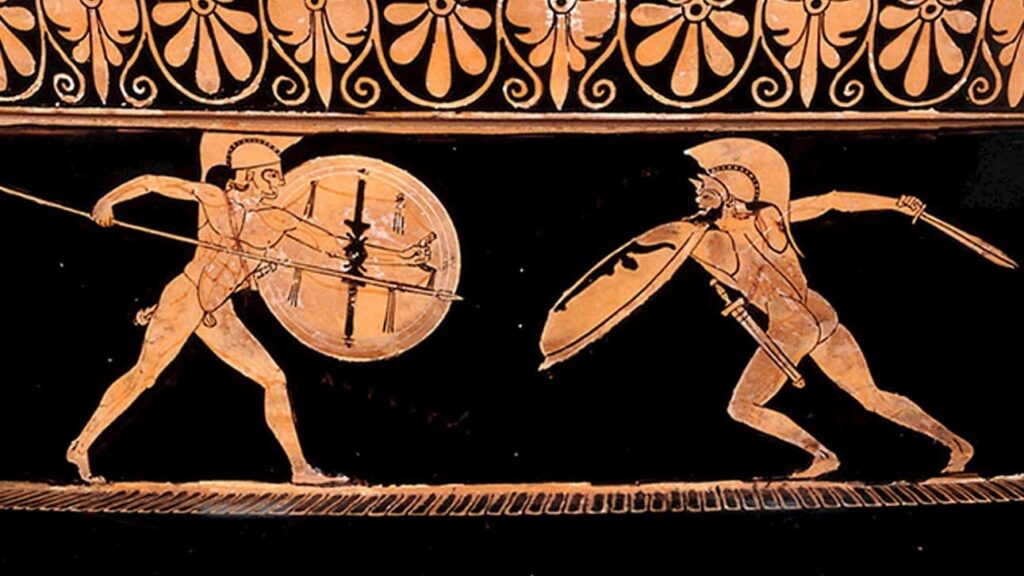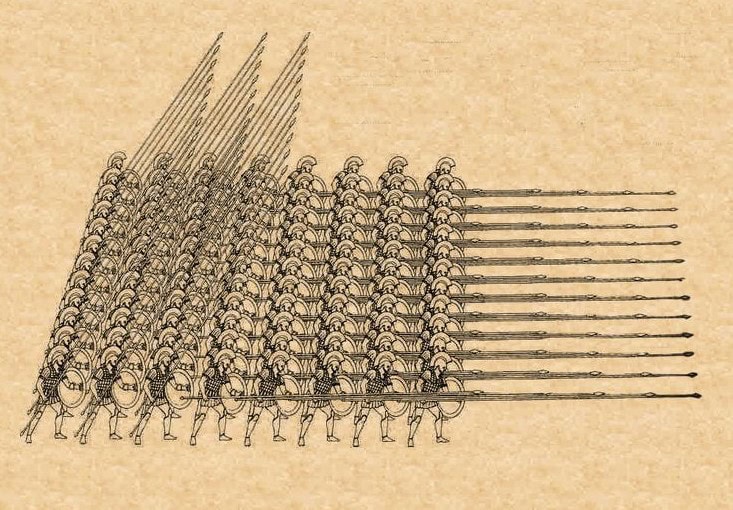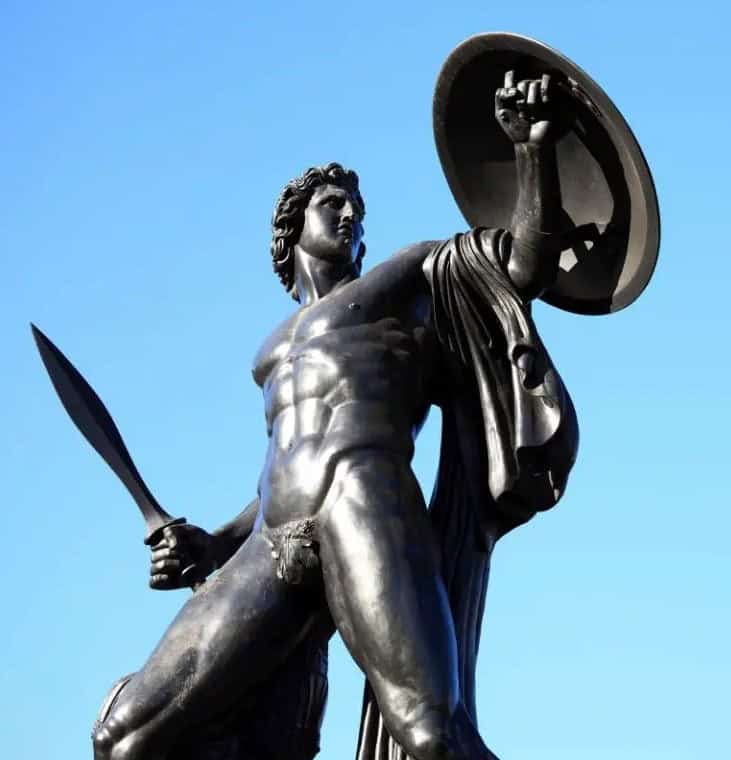Xiphos Sword for Sale: Become a Keeper of Greek Craftsmanship
TLDR: The xiphos sword, a double-edged, leaf-shaped weapon used by ancient Greek hoplites, was essential in close combat and is steeped in mythology, often associated with legendary heroes and extraordinary properties.
When I first stumbled upon the xiphos sword, I was immediately captivated by its design and historical significance. This ancient Greek weapon, with its distinctive leaf-shaped blade and practical functionality, played a crucial role in the battles of antiquity. It’s fascinating to think about how the xiphos evolved from earlier sword designs and became a staple for hoplite warriors, who relied on it not just as a secondary weapon but as a vital tool in close combat. The craftsmanship that went into each sword reflects the ingenuity of its time, and I find myself drawn to the stories of the warriors who wielded them on the battlefield.
Origins of the Xiphos Sword
The xiphos sword has its roots in the Mycenaean period, which lasted from approximately 1600 to 1100 BC. During this time, longer swords were prevalent, reflecting the combat styles and technologies of the era. As Greece transitioned into the Archaic period (circa 800-500 BC), the xiphos emerged as a more practical alternative. This shorter sword offered greater maneuverability, making it particularly suitable for the evolving tactics of Greek warfare, especially within the tightly packed formations of hoplite soldiers. The design of the xiphos was influenced by earlier sword types, incorporating elements that enhanced its effectiveness in close combat. The shift from longer blades to the more compact xiphos marked a significant evolution in weaponry, aligning with the changing nature of warfare in ancient Greece.
Evolution of Materials of the Xiphos Sword
Initially, xiphos swords were crafted from bronze, a material that was widely used in the ancient world due to its availability and ease of shaping. However, around 1200 BC, a pivotal transition occurred as iron began to replace bronze in weapon manufacturing. This change was not instantaneous; rather, it unfolded over several centuries during which both bronze and iron swords coexisted. The introduction of iron brought notable advancements in metallurgy, resulting in swords that were not only more durable but also capable of being sharpened to a finer edge. The increased hardness of iron allowed for better performance in combat situations, enhancing the effectiveness of the xiphos as a weapon.
| Material | Time Period | Characteristics |
| Bronze | Mycenaean Period | Softer, easier to shape; good for casting |
| Iron | Post-1200 BC | Harder, more durable; superior sharpness |
Adoption and Spread of the Xiphos Sword
The xiphos quickly became integral to Greek military equipment and was widely adopted across various city-states and colonies, including regions such as Asia Minor, southern Italy, and Sicily. As Greek culture spread through trade and colonization, so too did the xiphos sword. It became a standard part of the armament for hoplite warriors—heavily armed infantry who fought in phalanx formations. In these formations, where soldiers stood shoulder to shoulder with shields interlocked, the compact size and versatility of the xiphos made it an ideal secondary weapon. When their primary weapon, the spear (dory), became ineffective or was lost during battle, hoplites relied on their xiphos for close-quarters combat. This integration into standard military practice not only solidified the xiphos’s place in warfare but also contributed to its enduring legacy as one of ancient Greece’s most iconic weapons.
Xiphos Sword Physical Characteristics
The xiphos was a masterpiece of ancient Greek weaponry, blending elegant design with practical functionality. Its compact length, leaf-shaped blade, and carefully balanced weight made it a versatile and lethal tool in the hands of a skilled warrior, excelling in the tight formations and chaos of Greek battlefield tactics.
Xiphos Sword Length
The xiphos sword’s blade design is a testament to the ingenuity of ancient Greek weaponsmiths. Its distinctive double-edged, leaf-shaped blade was not merely an aesthetic choice but a functional one, optimized for both thrusting and slashing attacks. The blade typically ranged from 45 to 60 centimeters in length, with a width that tapered from the hilt to the tip. This design allowed for quick, precise strikes in close combat situations, particularly within the tight formations of the Greek phalanx.
Xiphos Sword Shape
The blade’s leaf shape provided a wider surface area near the center, concentrating the sword’s mass and increasing its cutting power. Towards the tip, the blade narrowed, enhancing its piercing capability. This versatile design made the xiphos an effective secondary weapon for hoplites, who could quickly transition from their primary spears when engaged in close-quarters combat.
The hilt and grip of the xiphos were crafted with equal attention to detail and functionality. Hilts were commonly fashioned from durable materials such as wood, bone, or ivory, chosen for their strength and ability to absorb shock during combat. The choice of material often depended on the warrior’s status and resources. A protective guard, typically made of metal, was incorporated into the design to shield the wielder’s hand from enemy blades sliding down the xiphos during parries or thrusts.
Key features of the xiphos hilt and grip:
- Protective metal guard
- Ergonomically designed grip
- Leather wrapping for enhanced grip and comfort
- Pommel for balance and potential use as a striking weapon
The grip was often wrapped in leather, providing a secure hold even in the heat of battle. This wrapping not only improved grip but also offered comfort during prolonged use, reducing hand fatigue and blisters that could impair a warrior’s fighting ability.
Xiphos Sword Weight
Weight and balance were crucial factors in the xiphos’s design. The sword’s weight typically ranged from 700 to 1000 grams, striking a balance between heft for powerful strikes and lightness for agile maneuvering. The distribution of this weight along the blade’s length was carefully considered to achieve optimal balance.
| Aspect | Measurement |
| Blade Length | 45-60 cm |
| Total Weight | 700-1000 g |
| Balance Point | ~10-15 cm from guard |
The balance point of a xiphos was typically located about 10 to 15 centimeters from the guard. This placement allowed for quick changes in direction during combat, enhancing the sword’s responsiveness in the hands of a skilled warrior. The well-balanced design facilitated both offensive and defensive maneuvers, enabling swift transitions between thrusts, cuts, and parries.
This careful attention to weight and balance made the xiphos an exceptionally maneuverable weapon, particularly suited to the close-quarters combat often encountered in ancient Greek warfare. The sword’s design allowed warriors to maintain control and precision in their strikes, even in the chaotic environment of battle, where quick reactions and efficient movements could mean the difference between life and death.
Combat Functionality of the Xiphos Sword
The combat functionality of the xiphos sword was integral to the effectiveness of Greek hoplite warfare. While the spear (dory) served as the primary weapon, the xiphos played a crucial secondary role, particularly in close combat scenarios. When the fighting became too close for effective spear use, or if the spear was broken or lost, hoplites would swiftly transition to their xiphos. This adaptability was essential in the dynamic and often chaotic environment of ancient battles.
In tight formations, such as the renowned Greek phalanx, the xiphos proved invaluable. Its shorter length, typically 45-60 cm, allowed for effective use in confined spaces where longer weapons would be unwieldy. The sword’s design facilitated quick, powerful strikes in these close-quarter engagements, enabling warriors to exploit gaps in enemy defenses or respond rapidly to threats.
The combat techniques employed with the xiphos were diverse and effective. Warriors were trained in both slashing and stabbing motions, utilizing the sword’s double-edged blade to maximum effect. The leaf-shaped design of the blade allowed for powerful cuts, while its tapered point was ideal for thrusting attacks, particularly against armored opponents. Parrying with the xiphos was also a critical skill, with warriors using the blade and sometimes the hilt to deflect incoming strikes.
When compared to other contemporary weapons, the xiphos held its own unique advantages:
- Versatility in close combat
- Ease of use within tight formations
- Effectiveness against both armored and unarmored opponents
- Quick transition from defensive to offensive maneuvers
| Weapon | Primary Use | Effective Range | Blade Type |
| Xiphos | Slashing/Thrusting | Close | Double-edged, leaf-shaped |
| Kopis | Chopping | Close to medium | Single-edged, forward-curved |
| Gladius | Thrusting | Close | Double-edged, straight |
The xiphos’s integration into Greek tactical doctrine was seamless. Within the phalanx formation, it served as a reliable backup to the spear, allowing hoplites to maintain their effectiveness even when the formation was broken or penetrated. The sword’s maneuverability in tight spaces meant that even in the densest parts of the battle, a warrior could effectively defend himself and strike at opponents.
Moreover, the xiphos’s design complemented the use of the aspis (the large Greek shield). Warriors could thrust or slash with the sword while maintaining a defensive posture behind their shield, a technique that was particularly effective in the pushing and shoving matches that often characterized phalanx warfare.
Mythology and Legendary Tales
The xiphos sword holds a significant place in Greek mythology and legendary tales, often associated with renowned heroes and imbued with extraordinary properties. These mythological references not only enhanced the sword’s cultural significance but also reflected the values and beliefs of ancient Greek society.
In Greek mythology, several notable heroes were associated with the xiphos. Perhaps the most famous was Achilles, the legendary warrior of the Trojan War. While Achilles is often depicted with a spear, some accounts describe him wielding a xiphos in close combat, emphasizing his skill as a well-rounded warrior. Another prominent figure linked to the xiphos was Perseus, who used a sword given to him by the gods to slay the Gorgon Medusa. Although not always explicitly described as a xiphos, the sword’s depiction in art and literature often resembles this Greek weapon.
Theseus, the mythical founder-king of Athens, was also said to have used a xiphos in his legendary exploits, including his defeat of the Minotaur. The sword played a crucial role in his identity as a hero, symbolizing his courage and resourcefulness. Additionally, Odysseus, known for his cunning and versatility, was frequently portrayed with a xiphos during his epic journey home from Troy.
Legends often attributed extraordinary properties to xiphos swords, elevating them beyond mere mortal weapons. These mythical blades were said to possess unmatched sharpness, capable of cutting through any material with ease. Some tales spoke of xiphos swords that could never be dulled, maintaining their edge even after countless battles. Others described blades with the ability to cut through magical barriers or defeat supernatural creatures impervious to ordinary weapons.
Mythical xiphos swords and their legendary properties:
- Unbreakable blades forged by Hephaestus
- Swords imbued with divine power by Zeus
- Blades capable of harming immortal beings
- Xiphos that could change size at the wielder’s will
- Swords with the ability to return to their owner’s hand when thrown
| Hero | Mythical Xiphos | Legendary Property |
| Achilles | Peleus’ Sword | Unmatched sharpness |
| Perseus | Harpe | Ability to slay immortals |
| Theseus | Sword of Aegeus | Unbreakable blade |
| Odysseus | Sword of Euryalus | Self-sharpening edge |
Some legends spoke of xiphos swords possessing magical abilities, such as the power to control the elements or grant their wielders superhuman strength. These mythical weapons were often said to be gifts from the gods or forged by divine craftsmen like Hephaestus, the god of metalworking. Such tales not only added to the mystique of the xiphos but also reinforced the idea of divine favor bestowed upon great heroes.
The mythological associations of the xiphos extended beyond its physical properties. In some stories, the sword was portrayed as a symbol of justice and righteous power. Heroes wielding these legendary xiphos swords were often depicted as champions of order and protectors against chaos, reflecting the Greek ideals of heroism and virtue.
Where Can I Find a Xiphos Sword for Sale?
For those interested in owning a Xiphos sword, numerous options are available from online retailers, historical replica shops, and specialty weapon stores. Whether you’re a history enthusiast, a collector, or simply captivated by ancient Greek weaponry, you’ll find Xiphos swords in a variety of styles, from authentic replicas to decorative versions.
Kult of Athena
Greek Xiphos

Features:
- High Carbon Steel Blade: The Greek Xiphos features a leaf blade forged from high carbon steel, ensuring durability and a swift, agile performance.
- Authentic Design: Replicated from historical designs, this Xiphos includes a steel hilt with carved wood, a steel guard, and pommel cap, providing an authentic look and feel.
- Handcrafted Scabbard: The wooden scabbard is handcrafted and bound in leather, with carved wooden chape and locket, and integrated brass hanging rings for added authenticity.
Greek Brass Hilt Hoplite Xiphos Sword

Features:
- Blade: Unsharpened carbon steel blade with a raised central rib, measuring 23 1/4” in length, and featuring a Xiphos design.
- Hilt: Solid cast brass hilt, providing an authentic Greek aesthetic.
- Dimensions: The sword has an overall length of 29 1/2”, a weight of 3 lb 8 oz, and a grip length of 4 1/8′
Etsy
22 in Hand Forged Xiphos by ExGurkhaKhukuri

Features:
- Hand Forged in Nepal: Each Xiphos sword is meticulously handcrafted in Nepal, ensuring exceptional craftsmanship and attention to detail.
- Durable Construction: The blade is crafted from 5160 leaf spring steel, providing durability and strength, while the handle is made from Rosewood with Brass Bolsters for a comfortable and sturdy grip.
- Ready for Action: This Xiphos sword comes sharpened and ready for use, with a blade length of 22 inches and a Rockwell Hardness rating of 55-62 HRC, making it a formidable tool for cutting and thrusting.
28 in Hand Forged Xiphos by Everestforged

Features:
- Hand-Forged Xiphos: Crafted using traditional Nepalese forging techniques, this Xiphos sword is a true work of art, echoing the historical Greek design.
- 28-inch Carbon Steel Blade: The 28-inch blade is made of high-quality carbon steel, balanced and water-tempered along the edge for exceptional performance and semi-polished for a stunning finish.
- Rosewood Handle and Sheath: The 12-inch full tang handle is meticulously crafted from Rosewood, providing both durability and elegance. Additionally, a sheath is included for safe storage and transport.
Conclusion
Reflecting on the xiphos sword, I can’t help but admire its blend of form and function. This weapon was more than just a piece of metal; it was a symbol of the warrior spirit in ancient Greece. The way it seamlessly fit into the tactics of phalanx warfare speaks volumes about its design and purpose. While I may not be an expert, I appreciate how the xiphos encapsulates a rich history of combat and craftsmanship. It’s incredible to think that such a simple yet effective weapon could shape the course of battles and influence generations of warriors.



